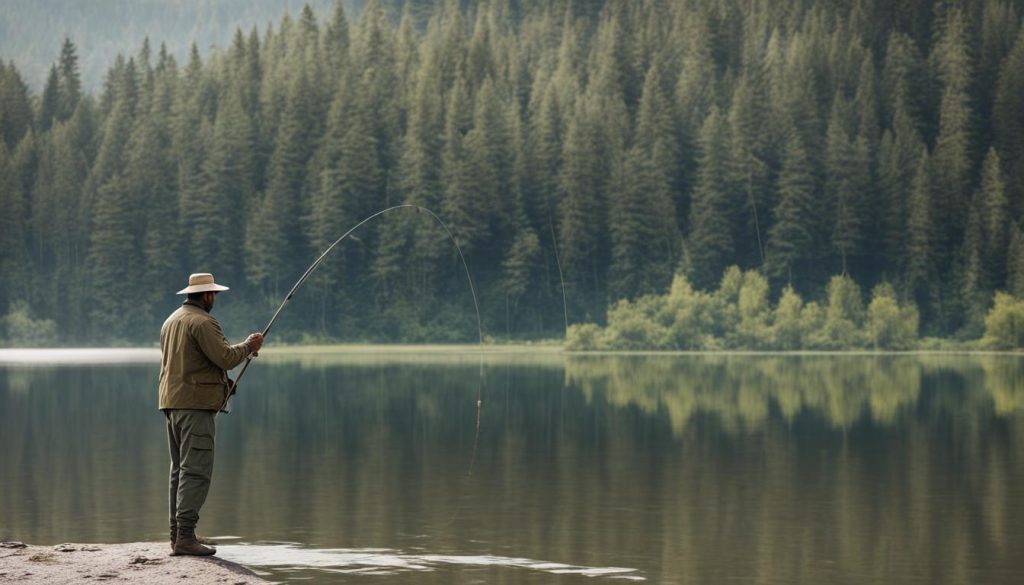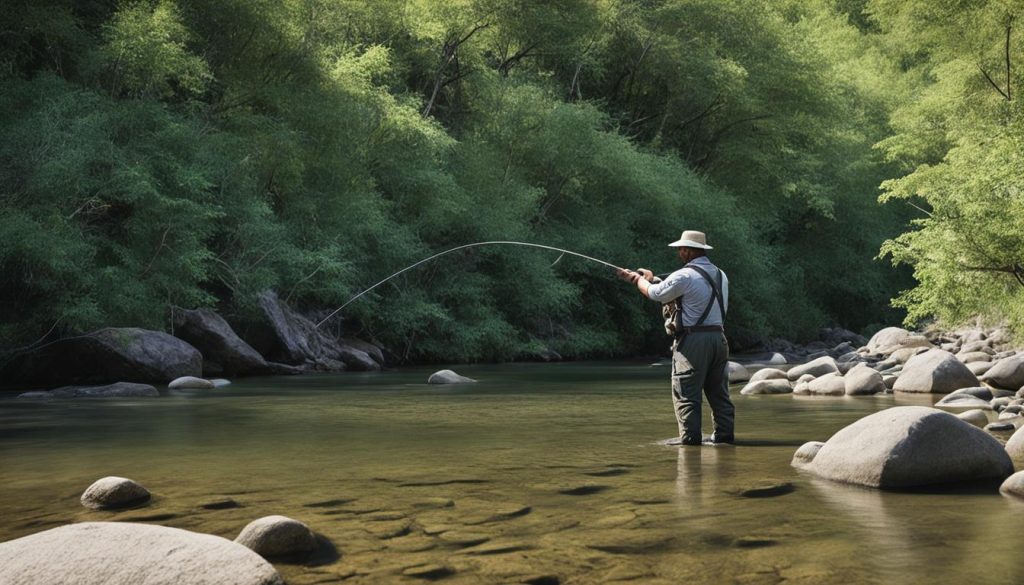Are you tired of scaring away fish every time you cast your line? Mastering the art of stealth casting is essential for any angler who wants to avoid alarming their quarry. With the right techniques and a little practice, you can make natural presentations and increase your chances of a successful catch without disturbing the fish.
In this article, we will share expert tips and fishing techniques for stealth casting. Whether you’re a seasoned angler or a beginner, these strategies will help you avoid scaring fish and enhance your angling experience.
So, let’s dive into the secrets of casting without alarming the fish and discover how you can improve your stealth techniques for a more successful and peaceful fishing trip.
Stay tuned for the next section, where we will delve into the specifics of mastering stealth in shallow waters!
Mastering Stealth in Shallow Waters
In shallow waters, mastering stealth is crucial to avoid scaring fish. When fishing in shallow areas, it’s important to employ techniques that allow for accurate and low-impact casting. This section will explore two effective techniques for achieving stealth in shallow waters: flipping and pitching, and utilizing roll casts for subtle presentations.
The Art of Flipping and Pitching Techniques
Flipping and pitching are specialized casting techniques that enable anglers to make precise and targeted presentations with minimal disturbance to the water’s surface. These techniques are particularly effective when fishing in close proximity to cover or in tight spaces.
When flipping, the angler keeps the rod partially extended and uses a short, controlled motion to drop the bait or lure into the desired spot. This technique allows for accurate placement while keeping the line and rod low to avoid alerting nearby fish.
Pitching, on the other hand, involves a more extended arm motion to propel the bait or lure towards the target area. It provides greater distance and precision for casting in situations where longer distances are required.
By mastering the art of flipping and pitching, anglers can achieve a stealthy approach and increase their chances of enticing fish in shallow waters.
Utilizing Roll Casts for Subtle Presentations
Roll casting is a casting technique that allows for softer landings and more subtle presentations. It is especially useful when fishing in areas with limited backcast space or when trying to minimize disturbances near the water’s edge.
When executing a roll cast, the angler begins by keeping the rod tip close to the water’s surface and then smoothly arcs the rod backward, loading it with energy. The angler then transitions into a forward motion, unrolling the line and gently placing the bait or fly onto the water with minimal disturbance. This technique ensures that the presentation appears natural and avoids spooking nearby fish.
Utilizing roll casts in shallow waters can give anglers an edge when targeting cautious or easily spooked fish. By mastering this technique, anglers can enhance their stealthy approach and increase their chances of success.
Perfecting Your Approach to Avoid Scaring Fish
Your approach is crucial when it comes to avoiding fish spooking. Mastering the art of approaching fish without scaring them is essential for a successful angling experience. By perfecting your approach, you can ensure that you don’t disturb the fish even before you cast your line.
To avoid scaring fish, consider the following fishing approach techniques:
- Move slowly and quietly: When approaching fish, it’s important to move slowly and quietly to avoid creating unnecessary disturbances in the water. Sudden movements or loud noises can startle fish and cause them to swim away.
- Stay low and keep a low profile: Try to keep a low profile by crouching or kneeling while approaching fish. This helps minimize your visibility and make you less threatening to the fish.
- Observe fish behavior: Take the time to observe how fish are behaving in their environment before making your approach. This can give you valuable insights into their feeding patterns and preferred areas, allowing you to plan your approach more effectively.
For boaters, it’s important to coast smoothly into your fishing position to avoid disturbing the surrounding environment. Minimizing the wake and using a trolling motor can help you approach fish without spooking them.
Waders should also be mindful of their approach. By stepping slowly and carefully, waders can avoid creating vibrations in the water that could scare fish away.

Clothing and Gear: Blending into the Fishing Environment
In the pursuit of stealthy fishing, blending into the fishing environment is essential. By choosing the right apparel and gear, you can effectively stay invisible to fish and increase your chances of a successful catch. It’s time to upgrade your fishing wardrobe and equip yourself with the tools to become one with the fishing environment.
Choosing the Right Apparel to Stay Invisible
When selecting fishing apparel for stealth, consider clothing that mimics the natural colors and patterns of your surroundings. Opt for earthy tones and muted shades that will help you blend seamlessly into the background. Additionally, choose garments made from light and breathable fabrics for ultimate comfort during long fishing sessions.
Investing in specialized fishing clothing with camouflage patterns can also provide added concealment. These patterns are designed to mimic the textures and colors of the surrounding environment, making it easier for you to blend in and avoid detection by wary fish.
Remember to choose clothing that suits the fishing conditions and weather. Don’t forget to layer up during colder seasons to stay warm and protected.
Minimizing Reflections with Non-Reflective Accessories
In addition to the right clothing, non-reflective fishing gear and accessories are crucial for maintaining a stealthy presence on the water. Choose reels, lures, and tackle with matte or non-reflective finishes to minimize glare and prevent fish from being spooked by shiny objects.
Consider using polarized sunglasses to reduce the amount of light filtering through the water’s surface, allowing you to see clearly while also reducing the chances of the fish spotting you. These sunglasses not only protect your eyes but also enhance visibility and reduce reflections, helping you maintain a low profile.
Opting for non-reflective fishing equipment and accessories ensures that you remain inconspicuous, giving you the upper hand in fooling even the most cautious fish.
Comparison of Fishing Apparel
| Features | Camouflage Clothing | Traditional Fishing Apparel |
|---|---|---|
| Blend into the environment | ✔ | ✖ |
| Minimize detection by fish | ✔ | ✖ |
| Reduce glare and reflections | ✖ | ✔ |
| Comfort and breathability | ✔ | ✔ |
Table: Comparison of Fishing Apparel
As shown in the table, camouflage clothing offers unique advantages in terms of blending into the environment and minimizing detection by fish. On the other hand, traditional fishing apparel provides enhanced comfort and breathability. When planning your fishing attire, consider these factors to make an informed choice that suits your fishing style and environment.
Strategies for Scaring Fish: How to Keep Your Quarry at Ease
Fishing success often hinges on keeping fish at ease, and understanding their vision and behavior is essential to achieving this goal. By delving into the concept of fish vision and the cone of sight, anglers can gain valuable insights into how to avoid detection and reduce the chances of scaring fish away.
Understanding Fish Vision and the Cone of Sight
Fish possess unique visual capabilities that differ from humans. They can perceive colors, but their vision is adapted to underwater conditions. To keep fish at ease, anglers must consider their cone of sight. Fish have a narrow field of vision, likened to a cone that extends forward from their eyes. This cone allows them to see what is directly in front of them and slightly to the sides while leaving their rear vision relatively limited. By understanding this cone and positioning themselves accordingly, anglers can avoid being spotted and disturbing the fish.
Techniques for Reducing Noise and Movements
Fish are sensitive to sudden movements and noise disturbances, which can quickly scare them away. To create a tranquil fishing environment, anglers should employ techniques to reduce noise and movements. This involves minimizing unnecessary sounds, such as dragging fishing equipment or banging on the boat, and making deliberate and slow movements when casting or reeling in. By being mindful of their actions and environment, anglers can maintain a calm atmosphere that keeps fish at ease.
Additionally, using quality fishing gear that operates quietly and smoothly can further reduce noise and minimize the chances of sudden movements that might alarm fish. Opting for equipment with low-friction components and utilizing smooth reeling techniques can help create a serene fishing experience.
By employing these strategies and techniques, anglers can ensure fish remain calm, minimizing the risk of spooking and increasing their chances of a successful catch. Keeping fish at ease is not only a skill but also a respect for the natural environment and the creatures that dwell within it, allowing for a harmonious angling experience.

